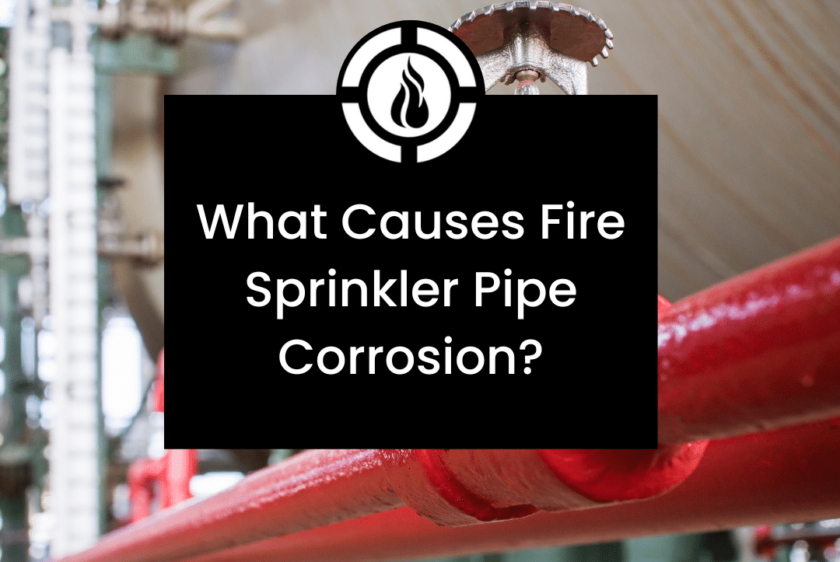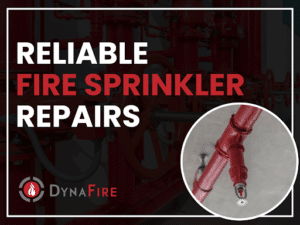Keeping fire sprinklers in good working condition can seem like a full-time job. Our team has some tips on keeping corrosion at bay and what to do if you need fire sprinkler pipe repair because of it.
If you ever left your bike in the rain, you know how quickly rust can start eating away at metal. Water + metal + oxygen = corrosion. This “corrosion triangle” impacts your fire sprinkler system’s pipes today just like it did to your old Huffy.
And when corrosion strikes, fire sprinkler pipe repair usually follows. But what if you can avoid corrosion altogether? Let’s explore how the corrosion triangle affects fire sprinkler systems and what you can do about it.
Why Is Corrosion A Problem?
So your pipes get a little rusty, so what? That’s normal, isn’t it? To some extent, rust is normal, but it can significantly impact your fire sprinkler system’s effectiveness. Corrosion can result in leaks, potentially compromise sprinkler systems, cause water damage, and ultimately necessitate the replacement of the entire system.
Even though rust is common for fire sprinkler systems, it’s an issue that needs mitigation and prevention as much as possible. A compromised fire sprinkler system can result in property damage from accidental discharge. Conversely, if the system fails to function when needed, it can lead to fire damage.
What Causes Corrosion?
The ever-present corrosion triangle creates most fire sprinkler pipe corrosion. This generalized electrochemical corrosion is responsible for up to 90% of corrosion in fire sprinkler systems. Another culprit responsible for 10-30% of corrosion is microbiologically induced corrosion (MIC), which occurs when corrosive elements facilitate bacterial colonization on the internal surfaces of sprinkler systems at the right temperatures.
Wet vs. Dry Pipes And Corrosion
Which are more vulnerable to corrosion, wet pipe or dry pipe systems? Wet pipes always have water, so you might think they’re more susceptible to corrosion. However, a recent study shows dry pipe systems are more likely to succumb to corrosion. Up to 70% of dry pipe systems have corrosion within 12.5 years of installation, while 35% of wet pipe systems have corrosion after 25 years.
Why? Oxygen. Dry pipe systems are filled with pressurized gas, and the ones filled with oxygen only need a small amount of water pooling from condensation or the last trip test to activate the corrosion triangle.
What To Do When You Need Fire Sprinkler Pipe Repair
We’ve established that corrosion is nearly unavoidable in fire sprinkler systems, so you must know what to do if you discover it. The extent of the damage determines whether you need fire sprinkler pipe repair or replacement. The NFPA has set guidelines to help you make that decision.
Class I – Flushing the pipe array is advised if little damage is found. NFPA 25 also recommends thorough cleaning and hydrostatic testing to ensure corrosion hasn’t weakened the pipe after flushing.
Class II – If some pipes are damaged and some are not, the damaged pipes should be replaced.
Class III – If significant corrosion and deposits are present, replacing the entire pipe array or substantial portions is recommended.
Your Fire & Life Safety contractor can determine the level of corrosion and damage to assess your needs for repairs or replacement.
Corrosion Prevention
As you can imagine, fire sprinkler pipe repair and replacement can be costly. Following these recommendations, you can proactively mitigate corrosion and keep your fire sprinkler system working correctly for decades.
Use nitrogen in dry pipe systems – Remember the corrosion triangle? Using nitrogen instead of oxygen as the pressurized gas in a dry pipe system cuts out one of the components in the corrosion formula.
Choose black steel over galvanized – Galvanized steel pipes have a zinc coating that protects them from moisture. But if there are small holes in the zinc, corrosion can happen faster, leading to quicker failure than with black steel pipes.
Air vents for wet pipe systems – Installing venting valves is an affordable solution to minimize oxygen corrosion by releasing trapped air in wet sprinkler pipes. Vents automatically shut off when water reaches them or can be closed manually after excess air removal.
Corrosion monitoring – Monitoring solutions vigilantly track metal loss or gas composition in both wet and dry systems, promptly alerting to any onset of corrosive activity.
Get regular inspections – Inspecting your fire sprinkler system is the best way to know if corrosion is forming. Professional fire sprinkler pipe repair technicians can watch for the early stages of corrosion and repair small areas of damage before a more significant replacement is required.
Corrosion Happens – We Can Help
Our team of fire sprinkler pipe repair technicians can help create a proactive plan for fire sprinkler system maintenance to combat corrosion before it starts. And when it does rear its rusty head, we can repair your pipes before the corrosion causes flood or fire damage. Contact us today for more fire sprinkler solutions.







